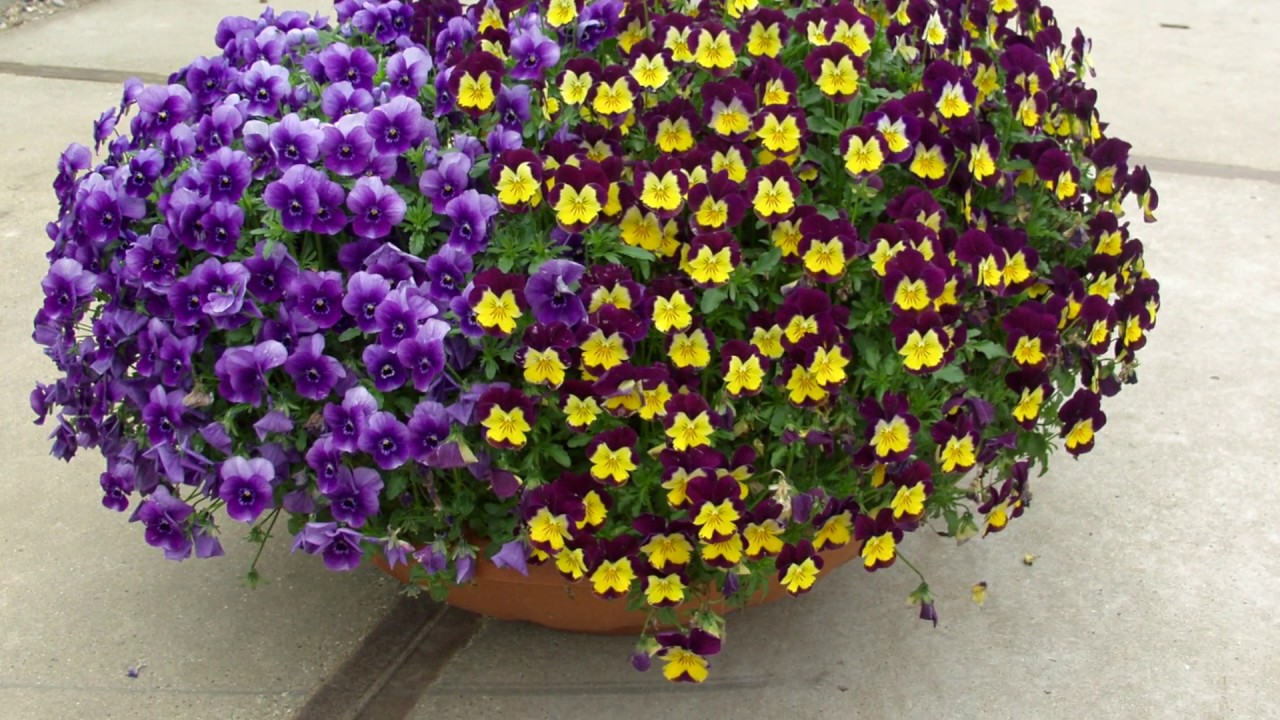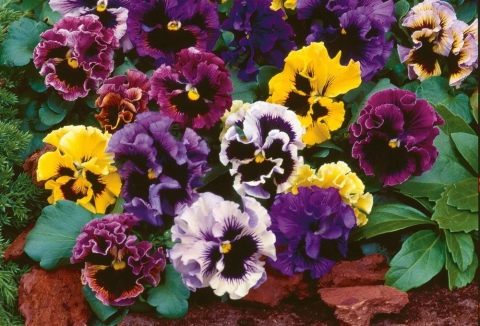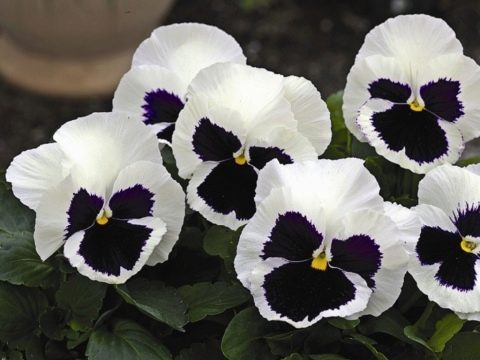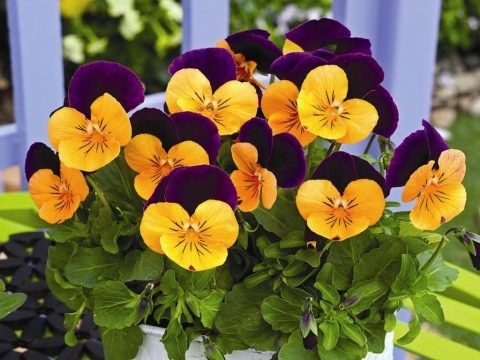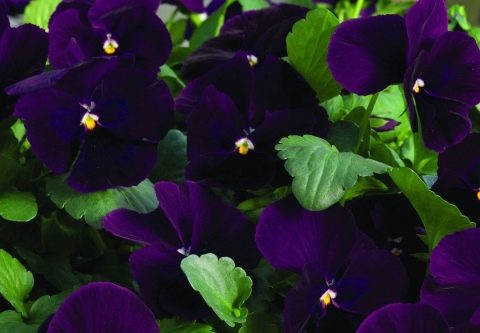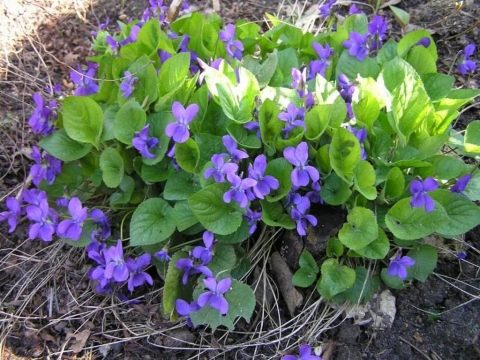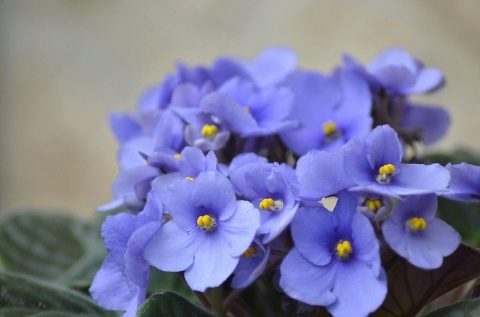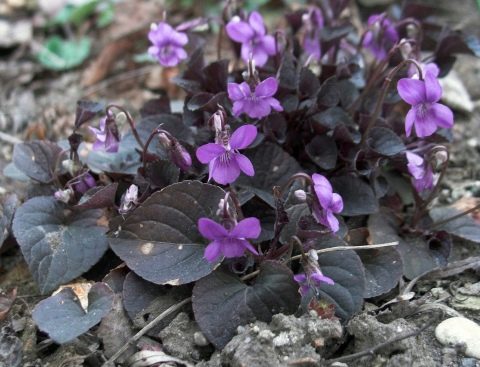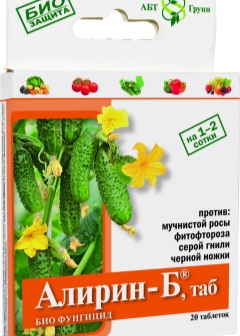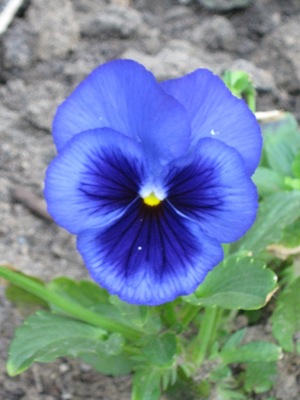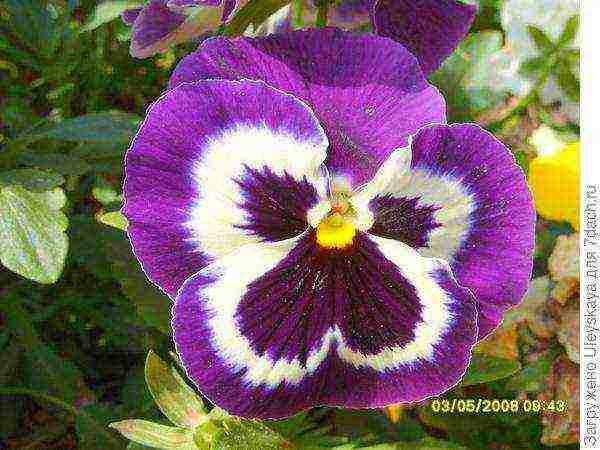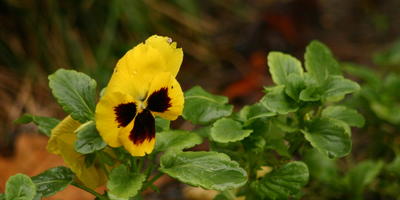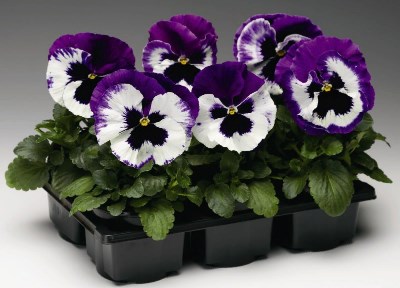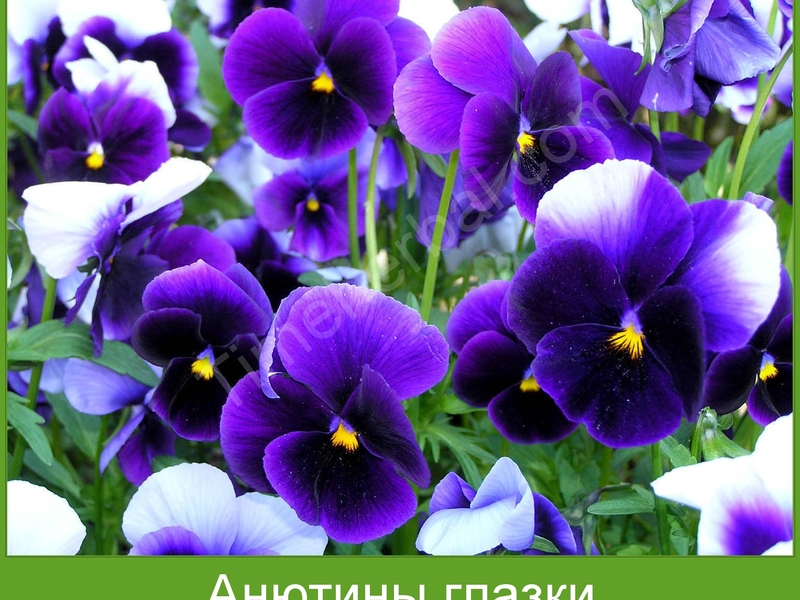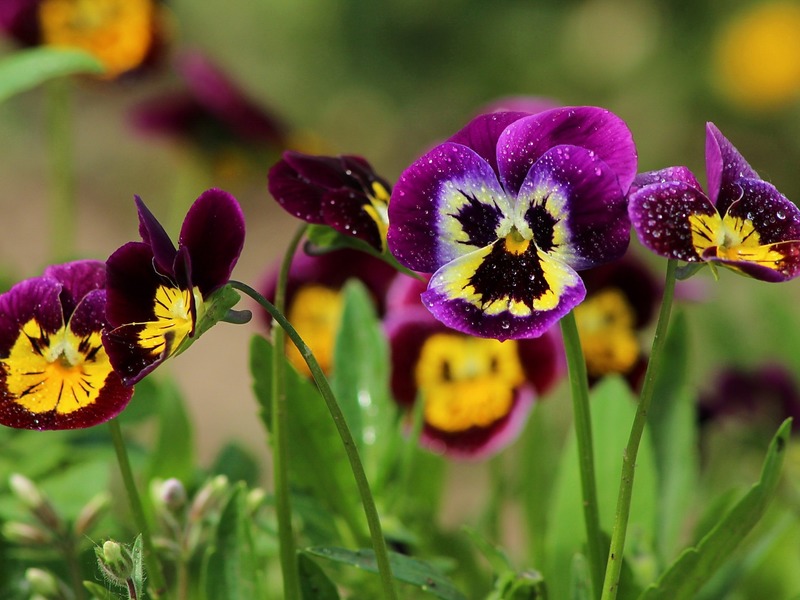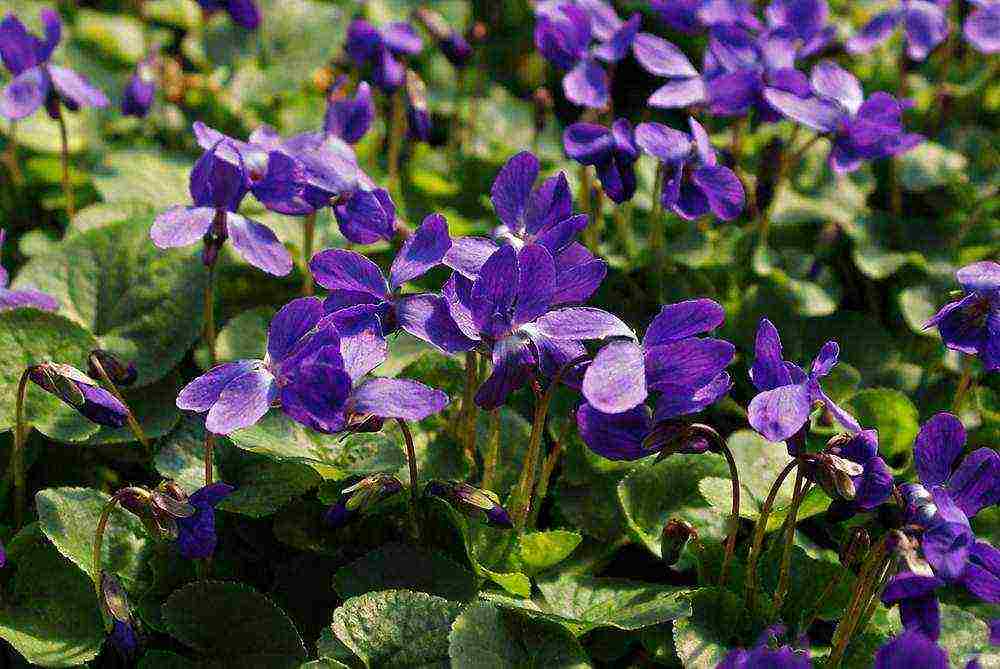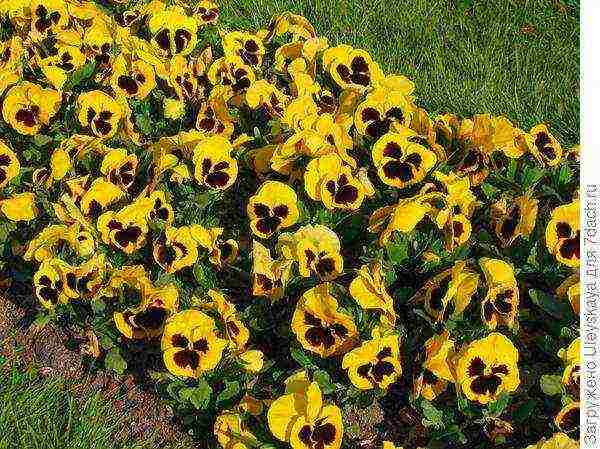Viola Wittrockiana
This is the most popular type of viola. Actually, they are mainly offered to us in the markets and in flower shops. Viola Vittroca flower is a hybrid created by crossing the tricolor violet (Viola tricolor), Altai viola (Viola altaica), golden viola (Viola lutea), horned viola (Viola cornuta) and some other species. Viola Wittroca is the garden pansy flowers.
 The Wittrock Violas are the most popular among the Violas. Actually, we most often see them on balconies and summer flower beds.
The Wittrock Violas are the most popular among the Violas. Actually, we most often see them on balconies and summer flower beds.
The upright bush of Viola Vittrok branches tightly and reaches 20-30 cm in height. Leaves - rounded-oval, with rounded teeth. The flowers are large (up to 6-11 cm in diameter) of irregular shape, of various shades, rise above the leaves. Petals are rarely monochromatic, more often colored veins, strokes, spots are clearly visible on them.
In the final years, ampel varieties of Wittrock's viola were bred. The lashes of such viols reach 30-40 cm, the flower - about 5 cm.Wittrock's ampelous viols are grown either in pots and hanging baskets, or as a ground cover capable of creating a flowering pillow up to 60-75 cm in diameter.
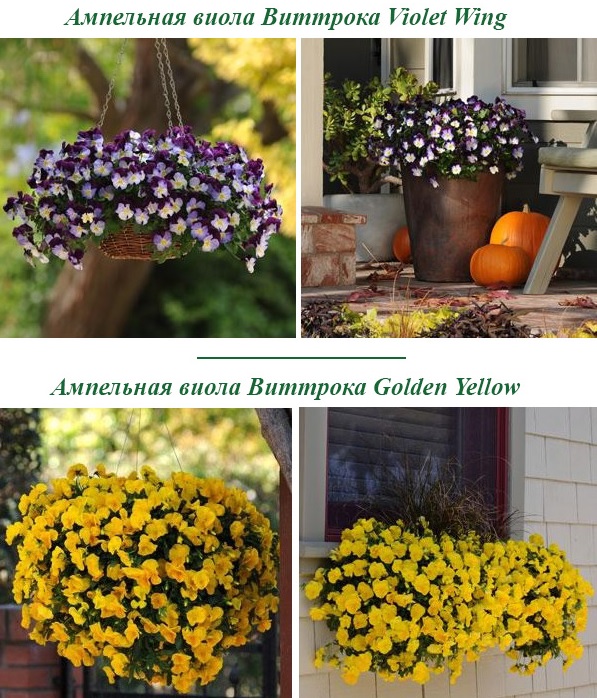
Viola Wittroca is traditionally revered as a biennial. However, with early crops (late winter or early March), it blooms in the year of planting, along with other annuals - in May-June. When sown in autumn, Vittrock's viola blooms the next year in early spring.
There are many varieties of Wittrock viola, some of which are grouped together. Here is some of them:
- Swiss giants are compact bushes with large colors, reaching 6-8 cm in diameter. The colors are bright, multicolored, with a traditional "eye" and a hopeless "butterfly" on the petals.
- Rococo is a variety series, the flowers of which have unusual corrugated petals. The size of the flowers is up to 6 cm. They are distinguished by bright colors, complemented by clear strokes and dark spots on the petals.
- Bambini is a very bright series with abundant flowering. Flowers can have different colors, a lot of delicate, pastel colors - bluish, pink, pale lilac, beige. In the central lobe of the flower there is a white or yellow butterfly. The flowers are quite large, reaching 6 cm in diameter.
- Manjestic Jants F1 (Majestic Giants Series F1) - giant flowers with a diameter of 9-10 cm? dazzling colors with a dark spot in the center in the form of a large bow. The next generation of Manjestic - Super Majestic Giants SeriesF - still has quite a few impressive flower sizes (11 cm).1.
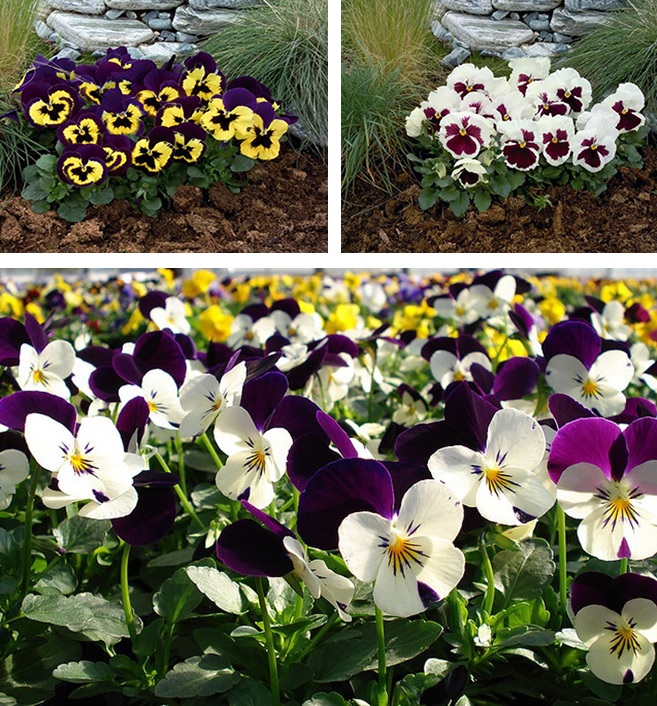 Violas Wittrock look especially impressive in mass plantings
Violas Wittrock look especially impressive in mass plantings
Sowing seeds
For growing ampel violets from seeds, a variety of containers with sufficient area are suitable. As for the substrate, it is possible to use nutritious and loose soils that retain moisture well. One example of a suitable soil is a mixture that includes garden soil, peat and humus (the optimal proportion is 2: 1: 1).
If the owner of viols wants to grow them as annuals, he should start sowing seeds in the second half of winter.
An alternative option is the cultivation of ampelous violets as biennials, the beginning of which must be postponed to the first half of the summer.
There are three ways to sow the seeds of the plant in question.
- With instillation. This method involves preparing grooves that are 5 mm deep and spaced 10 mm apart. In each of them, it is necessary to place seeds, observing a step of 10 to 20 mm. Further, the planting material must be covered with soil, thoroughly watered, covered with a transparent film and transferred to a dark room with room temperature. In order to avoid the development of pathogenic microflora, it is advisable to ventilate the soil twice a day, removing the "shelter" for 10-15 minutes.
- Surface. The described technique allows you to achieve a faster emergence of shoots (shoots do not need to break through the soil layer). To do this, water the soil with warm water, carry out the marking in accordance with the previously mentioned gap and distribute the planting material over the surface of the substrate.The further sequence of actions does not differ from the one given above.
- Combined. This method provides for following the algorithm described in the previous paragraph, up to and including the distribution of seeds over the surface of the substrate. Here, the planting material is sprinkled with a thin layer of soil (up to 2 mm), after which they adhere to the sequence of actions common to all methods.
In most cases, seedlings appear after a decade from the day of sowing. If the seeds are covered with too dense soil, this time interval increases by 2–3 times.
After the emergence of seedlings, the container should be exposed to the light as long as possible (the best option is from 12 to 14 hours a day). If there is not enough lighting, it makes sense for the plant owner to use phytolamps.
Despite the endurance of the seedlings of the described viola, experts advise to accustom them to fresh air gradually, daily increasing the duration of airing. The film can be removed immediately, but this will complicate the adaptation of young plants to the changed conditions of keeping.
Characteristic
Viola belongs to the violet family, in appearance its flowers are very similar to ordinary violets. It occurs naturally in mountainous areas and in the northern part of the country. In total, 700 species of viola are recognized in the world, some of them grow in Africa, others in Australia, there are varieties from the Andes and New Zealand. Viola is better known to domestic gardeners as pansies.
All large-flowered varieties can be classified as herbaceous plants, which can reach a height of no more than 300 mm. The root system is fibrous, the stems are erect. The leaf plates have stipules, which are sometimes dissected.
Flowers are formed one by one, the diameter, depending on the variety, can reach 70 mm. Peduncles grow long. Flowers differ in shape and color, among the varieties there are:
plain;
All large-flowered viols bloom profusely, but the budding period depends on when the plant is planted. Sometimes this is the second half of March, but more often - the end of summer and before the first frost. Plant breeders managed to develop hybrid varieties that are distinguished by long flowering throughout the summer.


